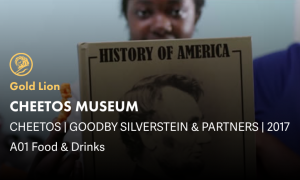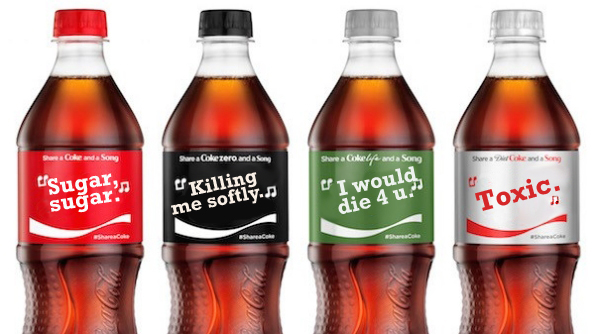The Oscars of the ad industry showcase latest techniques by junk food marketers
by: Fernando Quintero
posted on Wednesday, July 05, 2017
A Coke bottle that becomes a selfie stick. An online campaign that invites snack lovers to upload unusually-shaped Cheetos that are then showcased in a Cheetos museum. A Pepsi-sponsored online series on social media that features NBA star Kyrie Irving, who after hours of makeup and cosmetics is transformed into a trash-talking 80-year-old street baller.
 These are just a few examples of marketing campaigns highlighted in this year’s Cannes Lions International Festival of Creativity, a sort of Academy Awards for the advertising industry. The annual event is held in France and draws participants from around the world.
These are just a few examples of marketing campaigns highlighted in this year’s Cannes Lions International Festival of Creativity, a sort of Academy Awards for the advertising industry. The annual event is held in France and draws participants from around the world.
What became increasingly clear after watching a sample of videos about the award winners was just how ubiquitous online consumer engagement has become as a marketing tool. Out with passive consumerism. In with digital campaigns, advergames, online film series and contests that primarily target youth and engage them so that they in essence become brand ambassadors.
Gone are the days when parents could monitor TV, radio and print advertising for candy, soda and other junk foods directed at their children. Today, companies can not only advertise to children directly, away from parental supervision, they can do it in a way that entices children with games and campaigns that offer prizes, cash awards, and most coveted of all by both advertisers and young consumers alike: opportunities to share and expand their presence on social media.
Take the Coke “Selfie Bottle” for example.
A video about the campaign, a winning entry in the “Promo and Activation” category, opens with the following explainer: “Millennials are a photo-driven generation. Their lives are contained in digital albums where there’s almost no room for brands. 2 out of 3 millennials block all web advertising. So how do we become a part of their lives? Simple, by becoming a part of their photos. With just a small tweak, we transformed the most famous bottle in the world … into a “Selfie Bottle.”
The small “tweak” consisted of a manufacturing adaptation that allows the plastic cap at the end of the Coke bottle to attach to a mobile phone’s screen, ensuring that the bottle — and the Coke brand — is prominently featured in the photos. This consumer-driven marketing is accomplished by users sharing their photos on social media.
Not only is this a prime example of companies using social media to extend their brand, it’s also an example of personalization — a marketing tool that is being used more and more in the Digital Age. Coke has become a master at manipulating consumers’ desire to feel special, unique and a part of something bigger. A recent campaign featured first or last names on cans of Coke. The campaign included a commercial spot aimed exclusively at members of the Latino community, many whom consider their Hispanic surname as source of cultural pride.
 There was also Coke’s “Share a Coke and a Song” campaign two years ago, which put favorite song lyrics on packaging and invited consumers to upload their favorite songs. The campaign was supported by social media, music-themed TV spots featuring Pop princess Selena Gomez, and a summer-long “experiential tour.” (After noticing the lyrics to a popular song on a Pepsi can during a trip to the corner store, I joined with several health advocates to start our own counter-marketing campaign with song lyrics and titles like “Toxic” and “Killing me Softly.”)
There was also Coke’s “Share a Coke and a Song” campaign two years ago, which put favorite song lyrics on packaging and invited consumers to upload their favorite songs. The campaign was supported by social media, music-themed TV spots featuring Pop princess Selena Gomez, and a summer-long “experiential tour.” (After noticing the lyrics to a popular song on a Pepsi can during a trip to the corner store, I joined with several health advocates to start our own counter-marketing campaign with song lyrics and titles like “Toxic” and “Killing me Softly.”)
While Gomez and other celebrities from music and sports have been used by marketers to target youth for decades, the use of “influencers” has grown to include anyone “with the power to affect the purchase decisions of others because of their real/perceived authority, knowledge, position, or relationship,” according to Boston-based marketing firm Mavrck. “An influencer doesn’t necessarily have to be some sort of celebrity, journalist, or blogger. He or she can be an everyday person with the right connections and social pull. People may not trust brands very much, but 90% of people believe brand recommendations from friends.”
Mavrck explains how influencers work: “Say you’re scrolling through your newsfeed during your lunch-break and see Kimberly from your yoga class posted about her new Lululemon leggings. There’s a good chance you might click her link, check out the leggings she bought, and potentially buy your own pair based on her recommendation. Kimberly may not be Beyoncé, Kim Kardashian, or a famous journalist, but she’s influenced your purchase decision and therefore she is an effective influencer.”
This technique becomes problematic when instead of leggings, the pre-teen version of Kimberly is being encouraged to post a video, photos or a favorite song title on social media that promotes an unhealthy product. Sodas and other sugary drinks, for example, are the No. 1 source of excess calories in the American diet. These and other junk foods and beverages have contributed to the alarming rise in diabetes and other nutrition-related diseases, especially among communities of color.
Perhaps it’s time public health starts its own marketing festival. Sure, we can showcase social marketing campaigns that use clever storylines or technology to encourage us to eat more fresh fruits and vegetables every day. But the highlight of my event would be a review of top media advocacy campaigns that resulted in public policy, like Chicago’s new soda tax. The countless volunteers and organizers who have worked so hard in Cook County and other places throughout the country to reduce soda consumption through policies such as an excise tax are the real influencers. They truly deserve the credit for getting the word out.



